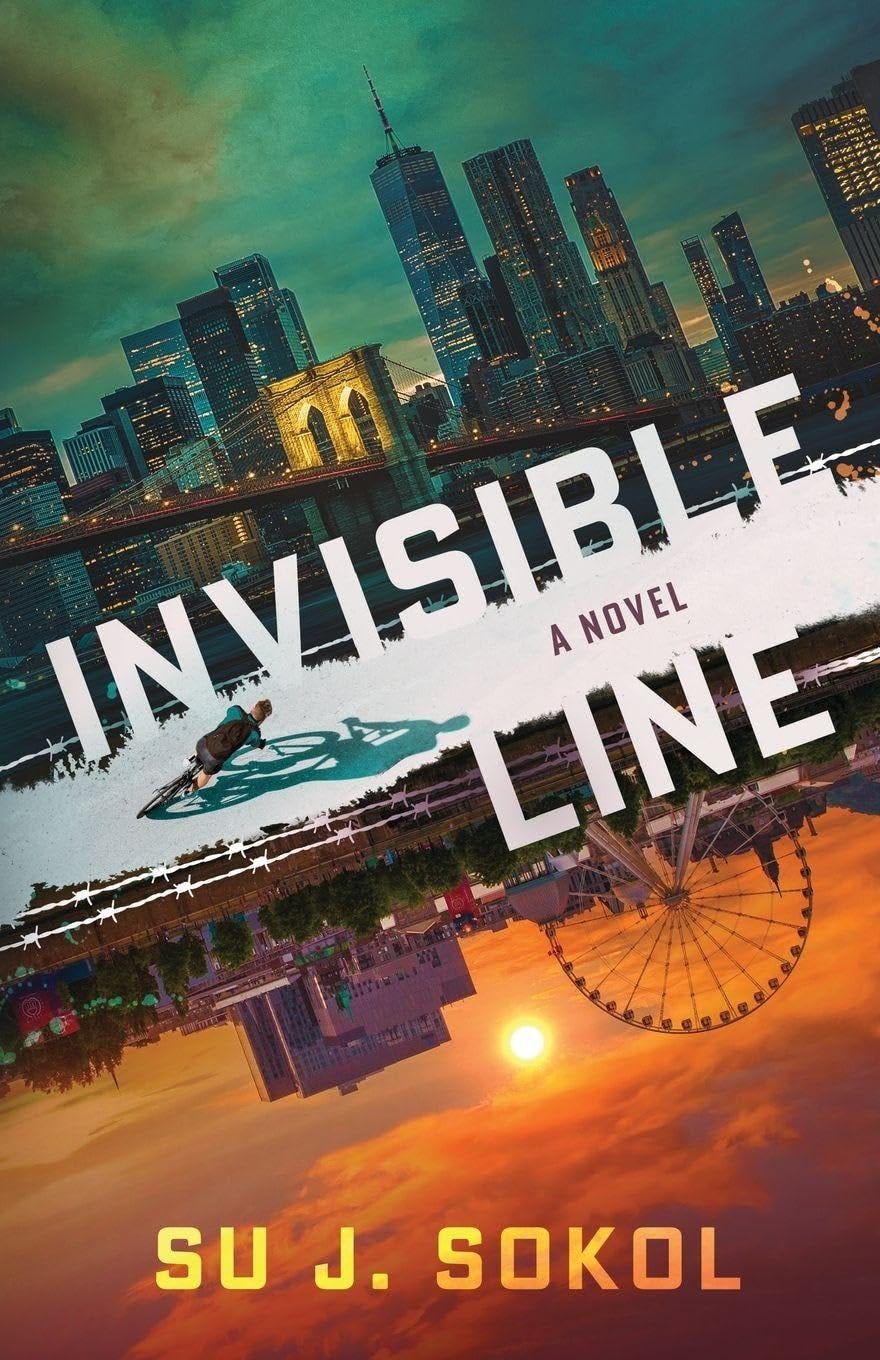Invisible Line by Su J. Sokol
Reviewed by Lisa Timpf
Readers get a number of cues to tell them Su J. Sokol’s novel Invisible Line is a work of speculative fiction. The use of holograms for communication and advertising, the practice of embedding ID chips in citizens’ wrists, and political changes like the United States becoming the United Americas are a few examples of the speculative elements included. Nonetheless, the events of Invisible Line, set at a time not so far from our present day, ring with authenticity.
Invisible Line is an updated re-release of Sokol’s novel Cycling to Asylum, which was originally published in 2014. In September, Sokol will release a sequel to Invisible Line, titled Five Points on an Invisible Line, which will follow the ongoing adventures of the characters introduced in Invisible Line.
To update Cycling to Asylum, Sokol combed through the original, updating terminology (such as “homeless” vs. “unhoused”) to match more current usage, making adjustments to the text to smooth out minor issues, and building in some additional character detail to enhance continuity with the sequel.
“One of Invisible Line’s appealing factors is that it goes beyond the usual tropes of speculative fiction as it explores issues like authoritarianism, activism, and community.”
At the outset of Invisible Line, Laek, Janie, and children Siri and Simon are living in New York, where Laek is a history teacher and Janie is an activist lawyer. Near the start of the novel, Laek undergoes a traumatizing experience at the hands of the police. He also has a mysterious past which he can’t risk having revealed to the authorities. As the authoritarian environment in the United Americas becomes more hostile, Laek and Janie decide to move the family to Montréal, Québec, where they plan to seek refugee status. Since they’re coming from the United Americas, which isn’t a place customarily recognized as an origin point for refugees, their request is not a slam-dunk.
Each chapter unfolds through the first-person viewpoint of one of the family members. The first-person perspective gives an immediacy to the events, and the use of different family members to tell the story gives readers a richer perspective. When reading the novel, I was struck by how life-like the characters felt. This increased my ability to empathize with their challenges.
As the story progressed, I found myself caught up in the events, as Sokol built in tension through the plot, raising questions about what might happen. Would the family be able to cross the border safely? Would their request for refugee status be granted? What really happened in Laek’s past? And so on.
One of Invisible Line’s appealing factors is that it goes beyond the usual tropes of speculative fiction as it explores issues like authoritarianism, activism, and community. Rather than battling monsters or aliens, the characters are fighting for the right to live their lives freely. The struggle isn’t physical, though there are physical aspects, like the bike trip. Instead of being armed with swords, magical abilities, or ray-guns, the family fights with resistance, hope, and their hearts and minds.
The family faces challenges as they work toward establishing themselves in a new place (in this case, with a new language to learn), and attempt to deal with the past while hoping for the future. Including children in the story line adds a layer of context as they, too, must adjust to a new home and come to accept and understand the necessity for the move.
Invisible Line takes place largely in New York and Montréal, Québec. Both places are depicted in convincing detail.
As a work of hopepunk, the story contains some darker elements, like scenes of police violence, a character struggling with PTSD, and other items. Content warnings are included in the author’s note on content at the start of the book.
In the ten-plus years since Sokol first wrote Cycling to Asylum, societal and political changes seem to have brought us closer to, not farther from, the authoritarian future depicted in the novel. Resonating with a sense of authenticity, Invisible Line is an engaging story that sets the stage for its soon-to-come sequel.
About the Author
Su J. Sokol is an activist and a writer of speculative and interstitial fiction. Xe is the author of three novels: Cycling to Asylum, which was long-listed for the Sunburst Award for Excellence in Canadian Literature of the Fantastic; Run J Run; and Zee, a finalist for the Janet Savage Blachford Prize for Children’s and Young Adult Literature. Sokol’s short fiction and essays have appeared in various magazines and anthologies. Originally from Brooklyn, New York where xe worked as a housing rights lawyer, Sokol has made xyr home in Montréal/Tiohtià:ke since 2004.
About the Reviewer
Lisa Timpf lives in Simcoe, Ontario, where she writes poetry, book reviews, short stories, and creative nonfiction. Lisa’s speculative poetry collections Cats and Dogs in Space (2025) and In Days to Come (2022) are available from Hiraeth Publishing. Lisa is a member of SF Canada and the Science Fiction and Fantasy Poetry Association. You can find out more about Lisa’s writing projects at http://lisatimpf.blogspot.com/. Lisa is also on Bluesky, @lisatimpf.bsky.social
Book Details
Publisher: Flame Arrow Publishing
Publication date: August 12, 2025
Language: English
Print length: 394 pages
ISBN-10: 1990368212
ISBN-13: 978-1990368219




